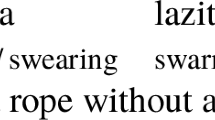Abstract
The present paper investigates the impact of structural ambiguity on humor creation in Russian. A range of jokes is analyzed which are based on the possibility of assigning two distinct structures to the same sentence, which, in turn, results in the emergence of two opposed scripts / scenarios / readings, as is necessary for the creation of a humorous effect. We consider several types of structural ambiguity, as well as the ways in which they interact with additional linguistic phenomena, such as homonymy, polysemy and the complement / adjunct distinction.
Аннотация
В данной статье исследуется использование структурной двусмысленности для создания юмористического эффекта. Мы исследуем ряд шуток, основанных на том факте, что одно и то же предложение может иметь две различные структуры. Итогом становится противопоставление двух сценариев / прочтений, что является необходимым условием для создания юмористического эффекта. В статье рассматривается несколько видов структурной двусмысленности, а также ее интеракция с другими лингвистическими явлениями, такими как омонимия, полисемия и различие между дополнением и адъюнктом.
Similar content being viewed by others
Notes
It is also possible that the adjectives are merged higher in the structure. This depends on one’s analysis of the syntactic function of adjectives. I will remain agnostic on this issue in the present paper since it does not affect the analysis of the jokes. For more information on different approaches to the syntactic role of adjectives, see e.g. Abney (1987), Cinque (1994), Delsing (1993), Sadler and Arnold (1994), Svenonius (1994).
ti represents the trace of the NP ėkskursovodov, which is base-generated in the object position and then undergoes movement.
In fact, this transitive use whose meaning is comparable to that of ‘provide’ or ‘produce’, may be regarded as an additional, second sense of the verb.
References
Aarons, D. (2012). Jokes and the linguistic mind. New York.
Abney, S. P. (1987). The English noun phrase and its sentential aspect (Doctoral dissertation, Massachusetts Institute of Technology).
Attardo, S. (1994). Linguistic theories of humor (Humor Research, 1). Berlin, New York.
Bailyn, J. F. (1997). Genitive of negation is obligatory. In W. Browne, E. Dornisch, N. Kondrashova, & D. Zec (Eds.), Formal Approaches to Slavic Linguistics (FASL-4). The Cornell Meeting 1995 (Michigan Slavic Materials, 39, pp. 84–114). Ann Arbor.
Borschev, V., Paducheva, E. V., Partee, B. H., Testelets, Y. G., & Yanovich, I. (2008). Russian genitives, non-referentiality, and the property-type hypothesis. In A. Antonenko, J. F. Bailyn, & C. Y. Bethin (Eds.), Formal Approaches to Slavic Linguistics (FASL-16). The Stony Brook meeting 2007 (Michigan Slavic Materials, 53, pp. 48–67). Ann Arbor.
Cinque, G. (1994). On the evidence for partial n-movement in the Romance DP. In G. Cinque, J. Koster, J.-Y. Pollock, L. Rizzi, & R. Zanuttini (Eds.), Paths towards universal grammar. Studies in honor of Richard S. Kayne (pp. 85–110). Washington.
Delsing, L.-O. (1993). On attributive adjectives in Scandinavian and other languages. Studia linguistica, 47(2), 105–125.
Dubinsky, S., & Holcomb, C. (2011). Understanding language through humor. Cambridge.
Goatly, A. (2012). Meaning and humour. Cambridge.
Gvozdev, A. N. (1955). Očerki po stilistike russkogo jazyka. Moskva.
Ickovič, V. A. (1974). Očerki sintaksičeskoj normy. In G. A. Zolotova (Ed.), Sintaksis i norma (pp. 43–106). Moskva.
Kagan, O. (2010). Genitive objects, existence and individuation. Russian Linguistics, 34(1), 17–39. doi:10.1007/s11185-009-9051-x.
Kagan, O. (2013). Semantics of genitive objects in Russian. A study of genitive of negation and intensional genitive case (Studies in Natural Language and Linguistic Theory, 89). Dordrecht.
Krikmann, A. (2007). Contemporary linguistic theories of humour. Folklore, 33, 27–57. Retrieved from http://www.folklore.ee/folklore/vol33/kriku.pdf (15 October 2015).
Partee, B. H., & Borschev, V. (2007). Pros and cons of a type-shifting approach to Russian genitive of negation. In B. D. ten Cate & H. W. Zeevat (Eds.), Logic, language, and computation. 6th International Tbilisi Symposium on Logic, Language, and Computation, TbiLLC 2005 Batumi, Georgia, September 12–16, 2005 (Lecture Notes in Artificial Intelligence, 4363, pp. 166–188). Berlin.
Raskin, V. (1985). Semantic mechanisms of humor (Studies in Linguistics and Philosophy, 24). Dordrecht.
Sadler, L., & Arnold, D. J. (1994). Prenominal adjectives and the phrasal / lexical distinction. Journal of Linguistics, 30, 187–226. doi:10.1017/S0022226700016224.
Stewart, T. W. Jr., & Vaillette, N. (Eds.) (2001). Language files. Materials for an introduction to language & linguistics. Columbus.
Svenonius, P. (1994). The structural location of the attributive adjective. In E. Duncan, D. Farkas, & Ph. Spaelti (Eds.), The proceedings of the Twelfth West Coast Conference on Formal Linguistics (WCCFL-12, pp. 439–454). Stanford.
Author information
Authors and Affiliations
Corresponding author
Rights and permissions
About this article
Cite this article
Kagan, O. Structural ambiguity in Russian humor creation. Russ Linguist 40, 1–10 (2016). https://doi.org/10.1007/s11185-015-9159-0
Published:
Issue Date:
DOI: https://doi.org/10.1007/s11185-015-9159-0




